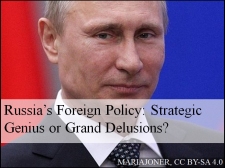Commentary by Danaë LAZARI
Foreign policy has traditionally held a high standing in the national policy of a state. Existing in the concept of ‘high politics’, it is an area widely regarded as a pinnacle of modern statehood, and is closely tied to national sovereignty. The very concept of an EU foreign policy is therefore probably enough to send Eurosceptics into a frenzy over the loss of (some might say the ultimate) national sovereignty – a perhaps not wholly unreasonable concern. If the EU is not, and does not aspire to become, a state in itself – how can it exercise its own foreign policy? This article will examine contemporary EU foreign policy and assess its role in the future in two parts. Part one will introduce contemporary EU foreign policy, while Part Two will outline how the future international landscape is likely to look, and what role EU foreign policy might play in it.
At the moment, the umbrella of EU foreign policy shelters two forms of foreign policy – conventional, and structural. Conventional foreign policy of the EU is difficult to define, not only because a foreign policy of the EU has only been formally developed in the past twenty years, but also because what has been developed cannot be understood in conventional foreign policy terms. Since the Treaty on European Union introduced the assertion of “[the EU’s] identity on the international scene, in particular through the implementation of a common foreign and security policy” as an objective, the EU has had a common, though not single, foreign policy, operating mainly under the umbrella of the Common Foreign and Security Policy (CFSP).

CFSP was introduced in 1993 as a fully-fledged foreign policy that would enable the EU to act cohesively and effectively on the world stage. However, it was rife with structural weaknesses – Member States, with their differing foreign policy capabilities and foreign policy visions, bargained and ultimately agreed on a policy whose institutional framework was administratively heavy and lacking any real delegation of power. Despite significant advances in CFSP since then, these weaknesses remain. The Lisbon treaty consolidated the role of High Representative of the Union for Foreign Affairs and Security Policy (HR) as well as creating the European External Action Service (EEAS). This was supposed to allow Europe to act with ‘one voice’ in matters of foreign policy. The Treaty transferred the military aspect of EU foreign policy to the EEAS, but external action capabilities, such as the European Neighbourhood Project (ENP) remained under the Commission. In other words, EU foreign policy-making is divided between CFSP and CSDP (Common Security and Defence Policy) on the one hand, and external action and policies on the other.
Ultimately, the EU cannot exercise foreign policy as understood in the conventional sense because it is not a unified actor following a well-conceived strategy towards its neighbours. Rather, what we can call conventional foreign policy of the EU is characterised by extremely complex policy-making procedures which, generally, are not conducive to foreign policy-making. They are not efficient in crisis management in the contemporary world, as evidenced by the EU’s response to the crisis in Libya. These institutional weaknesses are widely regarded as being one of the main impediments to the effectiveness of the EU’s foreign policy in the future.
Aware of CFSP’s weaknesses and unwilling to delegate the competences necessary to resolve them, Member States began, in the 1990s, to outline general EU strategies and partnerships towards other regions in the world. This was the beginning of the establishment of a structural foreign policy, which is defined as:
“a foreign policy which, conducted over the long-term, seeks to influence or shape sustainable political, legal, economic, social, security and other structures which can be situated at various relevant levels (individual, society, state, regional, global) in a given space.”

In other words, through structural foreign policy, the EU hopes to create a favourable or stable external environment by stabilising third country to its ‘way of doing things’. Historically, some of the most successful foreign policy endeavours of the EU have come under structural foreign policy – such as the 2004 Enlargement. Through the transformation of political, legal, and socio-economic structures in Central and Eastern Europe in order to meet the accession conditions, the EU strengthened the security situation of the whole continent.
However, in order to be successful, it is crucial that structural foreign policy tackles immaterial factors as well as material ones. In other words, it is critical that structural changes are seen as legitimate by the people concerned, who must incorporate them into their belief system or identity. The legitimacy of the EU as perceived by third countries is already waning due to a) its self-presentation as a normative actor, yet subsequent ill-handling of crises such as the Balkans and Libya, and b) its attempts to navigate internal crises such as the Eurozone crisis mean that the EU is more inward than outward-looking at the moment.
In Part Two, the article will analyse what the future international landscape is projected to look like, and the problems facing contemporary EU foreign policy if it is to be efficient in this future.
RELATED ARTICLES:





